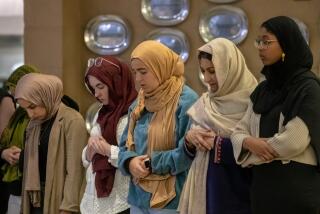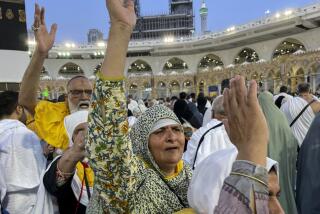Hindus show their Holi colors
Six-year-old Ishika Muchhal trembles with excitement as she hides near the park’s picnic benches, her face smeared with powdered paints: green, pink and red, with a splotch of blue on her forehead and a hint of yellow on her nose.
Earlier, she had been hit directly between the shoulders by a boy she calls “an enemy of mine.” There’s even a yellow and green drenched spot as proof.
She tells her tale gleefully, reenacting the scene with a smile and a hint of the dramatic. “I got sprayed in the back and I couldn’t even see the person spraying me,” Ishika says. “Now he doesn’t know where I am.”
Meanwhile, giggles and shrieks are heard as toddlers, teenagers and adults rub paint onto one another’s faces, arms and clothes. Children run, spraying water guns, drenching one another and making the colors run.
About 150 people from Southern California gathered Saturday at Arcadia Park to celebrate Holi -- the Pan-Indian “festival of colors,” a holiday celebrated by Hindus, Sikhs and some Muslims that rejoices in the coming of spring and the triumph of good over evil. It is considered a major Hindu festival.
The celebration was organized by the Hindu Temple and Heritage Foundation of Pasadena.
Manish Khemani, 24, of Northridge came to the United States from Mumbai, India, about two years ago, and this was his first Holi celebration in his new home. “It’s different,” he said, “Holi is much more intense in India -- more water, more colors, water balloons.”
But Khemani said he was pleasantly surprised and felt a little nostalgic.
The holiday falls on the full moon in the Hindu month of Falgun, usually around March. Traditionally celebrated over five days, it has been condensed in modern times to about two days. At night a bonfire is held, and people usually “play colors” the next day.
According to Hindu stories, the holiday commemorates the death of Holika, who represents evil, and the saving of her nephew Prehlad, who represents good.
One version of the tale tells of Prehlad’s father, Hiranyakshipu, an evil man who wanted Prehlad to worship him, not the Hindu god Vishnu. After many attempts to change his son’s mind, Hiranyakshipu decides to burn him to death, and his aunt, Holika, is to help. In the end, Holika is burned to death and Prehlad is saved.
Another story is about the Hindu god Krishna, who is said to have lived 5,000 years ago. He enjoyed dalliances with the milkmaids, especially Radha. On Holi, Krishna asked his mother why his skin was darker than Radha’s. His mother told him to rub paint on her. She retaliated and eventually, all the villagers joined in. Since then, Holi has also been celebrated with colors.
A holiday known for merriment and boisterousness, Holi is a special day, especially in India, because social restrictions and caste norms are relaxed.
“One of the things that Holi lets you do is let loose,” said Vinay Lal, a professor of history and Asian American studies at UCLA. “Holi is something anybody can take part in because you do not need anything, just water and color. You can go to the home of an upper-caste person and throw water at them and rub color on them. But the following day, everything reverts back to normal.”
In the United States, celebrants said it was a good day to take time off from hectic days of work, relax with friends and family and to renew friendships.
“If you are on bad terms with someone, you don’t need to speak words to them,” said Sonia Anand, 35, of Arcadia. “Sometimes the words hold you back, and all you need is some color and a hug.”
*
More to Read
Sign up for Essential California
The most important California stories and recommendations in your inbox every morning.
You may occasionally receive promotional content from the Los Angeles Times.










